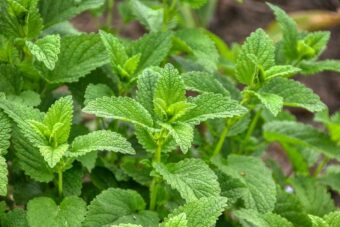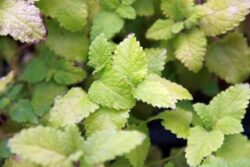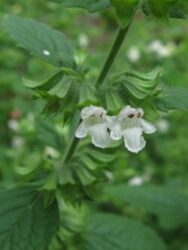In this article, we will discuss how to grow the wonderful scented and colourful herb Melissa officinalis (Lemon Balm) in containers. Lemon balm to give its common name is a perennial herb that has lemon-scented leaves and small, white or pale pink flowers in summer. The flowers are a magnet for bees, so great as part of a wildlife container garden. The flowers are insignificant compared to the leaves that can be green, gold or variegated, especially in early spring when new growth emerges.

It is a vigorous grower and like mint, it is best to grow them in containers to keep the rampant growth in check. A plant that is not fussy to where it grows as long as it is happy. The herb has multiple uses in the home fro, giving a kick to salads, sauces and fish dishes or infused in herbal tea concoction or used as part of a potpourri.
Find out how to grow this herb in containers in this article.
GROWING MELISSA OFFICINALIS IN CONTAINERS
You can either grow Melissa officinalis in containers as plant-ready garden specimens or you can easily grow from seed. Named varieties are only available as ready-grown plants,
From March to May, lightly scatter some seeds on top of a seed tray full of seed sowing compost that has been well watered. Cover the seed with a thin layer of sieved seed compost and then cover the seed tray with a propagator lid. Place it in a heated propagator or on a heat mat and wait for the seed to germinate.
After about 3 weeks the seedlings should have germinated and you can take the propagator lid off to allow the seedlings to have air and to grow on. Once they are large enough to handle, prick them out into individual 7.5cm pots full of multipurpose compost.
Once they are large enough and all frosts have passed and after you have hardened them off, you can plant them in containers outside.
At this stage, the garden-ready shop-bought plants and home-reared lemon balm seeds can be treated the same.
CHOOSE THE RIGHT CONTAINER

First, choose a large enough container that will look and suit the plants in question. As the plant can grow up to 80cm high, it is advised to use a 20cm diameter pot or larger. Whatever, you use make sure it has plenty of drainage holes in it. Fill the pot with a 1cm layer of gravel to help with drainage and on top of this add a moisture-retentive, multipurpose compost.
Dig a hole slightly bigger than the root ball of the plant, in the original container. Drop the plant in so that the top of the root ball is at the same level as the top of the surface of the compost. Backfill with the growing media, ensuring that any gaps are filled with more compost. Firm the plants in and water well.
You will need to keep the plant well-watered during dry periods in summer, especially so in hot weather. After it flowers, you can cut the spent blooms back to encourage new and tender leaves to grow. This is advised for two reasons; to promote the formation of new leaves as said before and to stop the plant from self-seeding everywhere.
CUT BACK VARIEGATED FORMS IN EARLY SUMMER
Variegated forms will appreciate a cut back in early summer to encourage new, colourful leaves to grow later on in the growing season.
As lemon balm is a long-lived plant, it can easily get congested in pots. It is therefore recommended to lift the plant every few years and divide it into two or three divisions to help rejuvenate the plant.
You may find it is better to grow lemon balm, especially the variegated varieties in light shade, as this will help the leaves to keep their colour and also to prevent the leaves from getting scorched. In containers, it is recommended to give the plant an annual dressing of slow-release fertilizer to give them a boost throughout the growing season. Not too much as you do not want to create a too vigorous growing plant.
PESTS AND DISEASES
Luckily the plant does not suffer from much in the way of pests and diseases, they can suffer from powdery mildew, which causes a white deposit to form on the leaves. It will also cause the leaves to grow stunted and shrivelled. Best avoided by keeping the compost moist and by improving air circulation around the plant itself.
VARIETIES TO GROW

‘All Gold’ has leaves that are yellow-gold making it a great foil to other green plants or purple flowers. Need to be grown in light shade to prevent scorching,
‘Aurea’ is a variety that has green leaves with splashes of gold on the serrated leaf edges.
Mellissa officanilis is the common, all green variety that is often seen in the garden.
‘Compacta’ is a dwarf version of the common lemon balm, which only grows up to 30cm in height. It is sterile and does not self-seed, which makes it ideal for small pots.
CONCLUSIONS
In this article, we have discussed how to grow Melissa officanilis in containers to not only bring colour and scent to the garden but also to provide a herb that has many uses in the kitchen and home.
Easy to grow from seed, easy to care for makes this an ideal plant in the container harden. The bees will love it as well.
If you have any questions or comments that you wish to make on growing Melissa in containers, please do so in the comment box below.
Happy Lemon Balm growing.
